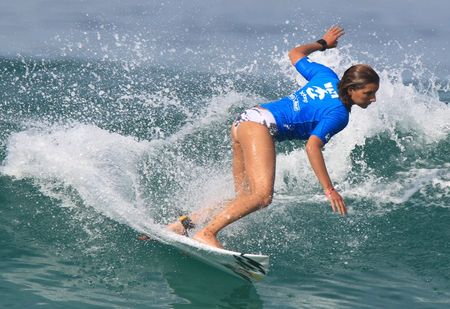
By Nicole Gheller
(Reuters) – Brazilian daredevil Maya Gabeira has improved her own world record for the biggest wave surfed by a woman, riding a 73.5 foot (22.4m) giant at Portugal’s Nazare and overshadowing the top male surfers in the process.
Gabeira, who broke her leg and almost drowned at the same spot in 2013, was towed by jetski into her winning wave during a World Surf League (WSL) Big Wave competition in February.
It not only topped her 68 foot (20.7m) record from 2018, also at Nazare, but was the biggest wave ridden by any surfer over the last year.
“This world record really strikes me as quite amazing because the size of the wave was taller than the men’s size this year,” Gabeira said.
“It means a woman actually rode the biggest wave of the year overall and that to me is crazy.
“I had dreamed of it years ago but not as something realistic because there was no representation for me to believe that it was possible.”
The winner of the men’s biggest wave for the year, Hawaii’s Kai Lenny, rode a 70-foot (21.3m) wave at Nazare. The men’s world record stands at 80 feet (24.4m).
France’s Justine Dupont was also in the running for the women’s world record. Her wave on the same day at Nazare was measured at only two to three feet smaller than Gabeira’s after the WSL had scientists analyse photographs and video footage.
“It’s amazing to see this new group of girls and there’s more awards now for women, there’s a record for women and now there’s more things to look up to and that’s very important,” Gabeira told Reuters.
In 2019, the WSL also became one of the first professional sports bodies to introduce equal prize money for men and women.
Critics of Gabeira early in her career said her fearless approach in big waves was putting herself and others at risk, especially after the horrendous wipeout https://www.youtube.com/watch?v=EZdOW2yStu0 in 2013 that saw her pulled out of the water unconscious.
“For many years after the accident, I think up until 2018, I was strongly trying to overcome my trauma and at times surfing wasn’t as much fun and there wasn’t a lot of pleasure involved in it,” she said. “It was a lot about being exposed to it and enduring the discomfort.”
Following the accident, she took up breath-hold training, preparing for the inevitable wipeouts and giving her the confidence to tackle waves like her Nazare record-breaker.
“The speed was very high but the noise that the wave made when it broke made me realise that this was probably the biggest wave I’d ever ridden,” she said.
(Reporting by Nicole Gheller in London; Editing by Lincoln Feast and Nick Mulvenney)